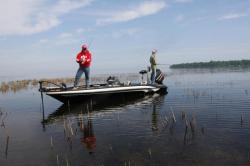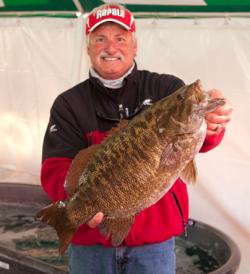Jackson proved to be as tough as Lanier, if not worse. The lake had turned over, never a good sign when it first happens. In the fall, as the surface of the lake cools due to cooler days and nights, the water at the top gets heavier. Cold water is heavier than warm water down to the point where it freezes.
All summer long the water in lakes is stable, with colder water at the bottom and warmer water at the top. This creates its own problems since the lower levels don’t get fresh, oxygenated water from upper levels. There is a section of water, called the thermocline, where the water drops in temperature and oxygen starts getting low. Below the thermocline the water is much colder and has little oxygen.
Fish tend to hold in the thermocline during the summer and move more shallow to feed. This limits them some. But as the surface water cools it starts falling and the lower levels will mix with the upper levels. This lowers oxygen content through-out the water column and makes fish sluggish most of the time. And they can move to any depth, so they become more scattered.
The water usually gets murky when turnover happens. It does not look muddy but is cloudy. Jackson had been very clear lately so when people said the lake had gotten stained, and we had no rain, I knew the lake had turned over. The water temperatures confirmed it.
The Potato Creek Bassmasters had a buddy tournament at Jackson last Saturday, the day before our two day tournament, and most of them had a tough day. A couple of fishermen had pretty good days but most did not. In fact, some members of the Flint River club that fished the buddy tournament on Saturday had such a bad day they did not come back to fish on Sunday.
We had 18 members of the Spalding County Sportsman Club and the Flint River Bass Club fishing for eight hours on Sunday. There were only 27 keepers weighed in. Two members had limits but there were eight fishermen that did not weigh in a keeper. The 27 keepers weighed 34.88 pounds and almost all were spotted bass.
Kwong Yu had a good day, landing one of the limits and winning with 8.96 pounds. His 2.60 pound bass was big fish. Raymond English had the other limit and came in second with 7.99 pounds. My four keepers weighed 5.35 pounds for third and fourth was Brandon Stooksbury with three at 3.35 pounds.
By 11:30 I was very frustrated. I had not hooked a bass even though I had fished a lot of places in four hours and tried everything I could think of to try. Then, to make matters worse, I missed a bite, broke my line setting the hook a few minutes later and then missed a third bite. I was about ready to give up.
I talked to two other fishermen at about that time and they had not caught any fish either. I decided to run way up the Tussahaw and try to scratch out a keeper. The first place I stopped, on a rocky point, I got a good keeper spot on a jig and pig.
After fishing around the area for more than an hour with only one more bite, another keeper spot that hit by a dock, I ended up where I caught the first one and caught two more keepers, one on a jig and pig and one on a jig head worm. I stayed there until the end of the tournament but could not catch another fish.
The tournament year is over for all three Griffin clubs now since Potato Creek fished their December tournament yesterday. We will all start over in January so now is a good time to plan on joining a club and showing all of us how to catch bass. The Flint River Bass Club meets at Hong Kong 2 the first Tuesday each month at 7:00, Potato Creek Bassmasters meet the Monday after the first Tuesday and the Spalding County Sportsman Club meets at Panda Bear the third Tuesday each month at 7:30 PM.
Each club fishes the weekend after the meeting except when we have two and three club tournaments. Both the Sportsman Club and Flint River fish on Sunday and Potato Creek fishes their tournaments on Saturday. So you have some choices of which weekend day to fish.
We have a lot of fun in the clubs and you can learn from other members, sometimes. Most members share how they caught their fish – after the tournament is over. But that is good info for the next time. And you can get good information on boats, motors, rods, reels and fishing lures and lines from other members based on what they use.
None of the clubs have draw tournaments so you and a friend can join and fish together. If you don’t have a boat or a friend with one, you can join and we should be able to find someone in the club for you to fish with.


